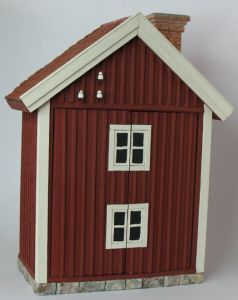Late in 2004, making miniature cottages from little house shaped cupboards (available at Michaels craft stores in the USA) was all the rage among 1:48 miniaturists, after an article in Dollhouse Miniatures magazine (October 2004). My friend Pam sent me one of these cupboards so I could be a part of it.
As the ceiling height was very low it was best suited for an old cottage. I decided on a setting around 1930, in an older house; and of course in Sweden.
Historical background
Up to the first half of the 20th century, the vast majority of the Swedes lived in the countryside. Due to some land reforms in the decades around the year 1800, farms were often situated far apart, so laying down infrastructure (water pipes, electrical wires etc) was costly compared to what it would've been if the houses had been clustered together in towns and villages.
As a result, Swedish countryside homes were not quite up to date, as these 1930 statistics show:
- About 50 % of the countryside homes had electric lighting.
- 20 % were fitted with water pipes and drains.
- 60 % of the homes had at most two rooms, not counting the kitchen.
- Out of these small homes, only 2 % had a shower or bath, and even fewer had a water closet.
Exterior

To disguise the flat surfaces of the original cupboard, I used various dimensions of stripwood for board and batten panelling, corner boards, bargeboards etc. I cut the windows from card. Red wall paint is traditional (using natural pigment, giving a somewhat muted shade), but a darker shade is favored compared to the 19th century and earlier. The stark white detailing emerged at the turn of the 20th century.
The chimney top is built up in layers, and covered with brick print card from the model railroad shop. The flashing at the base is just painted card.

I made the traditional pantile roof using pantile sheeting from the model railroad store. (Actually, I didn't use the sheeting as is but rather glued a sheet of PaperClay to the roof and immediately molded it using the sheeting; this made it easier to paint and age than if I'd used the sheeting straight off. The resulting pantiles don't look overly perfect, like the sheeting does.)
I wanted the exterior to have a 20th century touch, so I added the white china isolators (where the electric wires went into the house). They were typical of rural electrification at least into the mid-20th century. I made mine from Fimo.
Kitchen
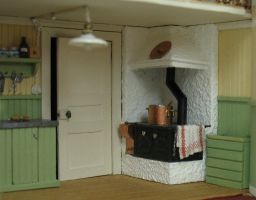
This style of wainscoting and cabinets was popular from the late 19th century into the 1920s, and the color scheme is typical of the early 20th century. The sink drains into a slop pail in the cupboard underneath. There's no water tap. A scouring brush for washing up lies next to the sink. On the bench is a pail of fresh water, with an enamelled ladle hanging over the edge.
Cast iron kitchen stoves started to become popular in the 1860s, but even if you built a house in 1900 you might build a traditional fireplace for a start and retrofit a cast iron stove later when economy allowed. This stove has the optional copper boiler. To the right of the stove is the firewood bin.
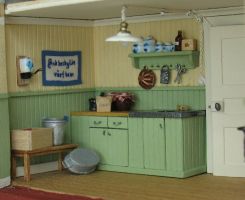
Mother is making lingonberry (cowberry) jam. The jam is boiling on the stove, and a crate with more berries sits on the bench to the left. On the kitchen counter, there are two brown salt-glazed jars already filled with jam, and a brown paper bag with sugar.
The "needlepoint" sampler (which I painted on fabric) says "God bless our home" in Swedish. I used Fimo for the porcelain jars and part of the coffee grinder. The blue pattern was painted on afterwards.
The wooden "box" on the shelf is a traditional measuring-jug. An official checked that they held the right volume and marked them with a stamp of approval so dealers could legally use them for measuring goods.
When houses were wired for electricity in early 20th century Sweden, they used twin cords on porcelain knobs. I imitated the look by using thick 2-ply nylon thread (possibly for beading) and painted pinheads. I used one of Grandt Line's lamp reflectors for the lampshade.
I made the door slightly open, by gluing it to a wedge of wood rather than flat against the wall. When my then 3.5 year old nephew got to see the house, he immediately tried to open the door to see what was beyond it... (no, he didn't break anything). Both doors in the house have traditional locks, with a chunky box and oval handle on the room side of the door, and just a key on the outside.
Bedroom
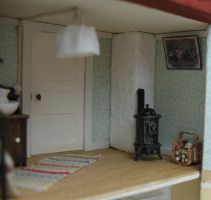
Cast-iron stoves were popular in the late 19th and early 20th century. In Sweden, many farmhouses got cylinder stoves (as they were comparatively light-weight they could be placed in any room, unlike the tiled stoves, which literally weigh a ton). Next to the stove is a chip basket full of firewood.
On the wall above the stove is a framed print of the royal family. At this time, paintings and prints were often hung right under the ceiling, as shown. Prints of the royal family were sold by a mailorder company from 1899 and on, and soon became their best selling product. Today and for the past several decades, old royal prints have typically been seen in countryside dry closets - my guess is that when people bought a new print, they used the old one to decorate the dry closet.
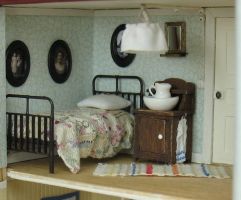
The iron head and foot boards is a set from Grandt Line, that I modified slightly to make them taller. I built the washstand and mirror from scratch, and sculpted the water jug and wash bowl from Fimo. There's a Fimo comb on the mirror's shelf.
I scaled down old family photos for the photos on the wall. The oval black frames, typical of the early 20th century, are repainted doll belt buckles.
Rag rugs on the floors became popular around 1870, when the papermills began to make paper from wood pulp. Earlier, the paper mills had been buying rags of linen and cotton to use as their raw material, but now they didn't need it anymore. Instead people started weaving rag rugs from their rags.
The bed has a real patchwork quilt (handstitched, but not quilted) that I made several years ago. Patchwork quilts haven't been appreciated as much in Sweden as in the USA or Britain. Apart from a brief patchwork fad in the middle/upper classes in the 19th century, they were often considered as a sign of poverty (maybe like wearing patched clothes?). Bed quilts were usually whole cloth quilts, often just grid quilted. When factory-made blankets became affordable (around the 1930s), people largely stopped using patchwork quilts.
